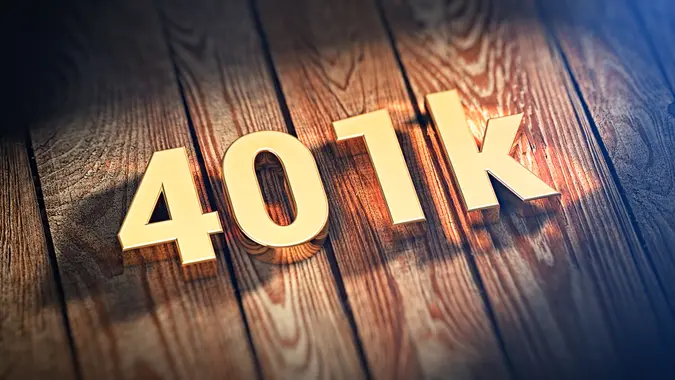Bank of America Study Reveals How Much Americans Contribute To Their 401(k) Plans

Commitment to Our Readers
GOBankingRates' editorial team is committed to bringing you unbiased reviews and information. We use data-driven methodologies to evaluate financial products and services - our reviews and ratings are not influenced by advertisers. You can read more about our editorial guidelines and our products and services review methodology.

20 Years
Helping You Live Richer

Reviewed
by Experts

Trusted by
Millions of Readers
If you have access to a 401(k) plan, you should take advantage of it, as it is one of the best ways to save for retirement. To maximize your 401(k), it is important to make consistent and sufficient contributions — and many Americans are rising to the occasion.
According to a new Bank of America study, Americans’ 401(k) account balances increased by 16% in 2024 compared to year-end 2023, as more plan participants increased their contribution rates in the last quarter of the year. Here is how much Americans contributed to their 401(k) plans last year.
The Average 401(k) Plan Contribution Rate in 2024
According to the study, the average contribution rate for 401(k) plan participants was 6.6% in the fourth quarter of 2024, up from 6.5% at midyear. The percentage you should contribute varies based on your circumstances.
“Individual contribution rates vary greatly depending on a range of personal circumstances, from your salary to your unique savings goals in retirement,” said Lisa Margeson, managing director of retirement research and insights at Bank of America. “At a minimum, you should aim to contribute at a level that ensures you receive the full match available from your employer so you are not leaving money on the table.”
Ideally, Margeson recommends contributing at least 10%.
“Although it can sometimes feel daunting to take money out of your hard-earned paycheck and put it toward retirement, contributing to your 401(k) plan now has long-term advantages,” she said. “Even if it is a small percentage of your monthly income, putting a little bit of money in your 401(k) plan every month will help you grow your nest egg over time and ensure you benefit from compound interest.
“To ensure growth over time, it is also important to incrementally increase your contribution rate,” Margeson continued. “Consider meeting with a financial advisor who can give you personalized guidance on how to meet your goals and strategically increase your contribution relative to your expenses and income.”
It is also essential to remember that your 401(k) plan should be one part of your overall financial plan.
“Focus on how you are saving and investing across the board, whether that is through your 401(k) plan, your health savings account (HSA) or other employer-sponsored vehicles,” Margeson said. “To determine what makes sense for you, consider using financial planning tools offered by your employer. These platforms can provide recommendations and benchmarks to ensure you are making progress toward retirement.”
When To Increase Your Contribution Rate
The study found that while 3 in 4 participants kept their contribution rate consistent, 21% increased their rate in the last quarter of the year.
“There are a few factors that may indicate it is time to increase your contribution rate, from changes in life circumstances to individual financial circumstances like a pay raise,” Margeson said. “Regardless, it is good practice to evaluate your 401(k) plan contribution rate at least annually to determine if you need to make adjustments.
“Employees should also take advantage of automatic contribution rate increases to their 401(k) plan that may be offered through employer plans,” she continued. “This will ensure you are fostering steady growth for your 401(k) plan without manually updating it.”
How Much Do Americans Have in Their 401(k) Plans?
According to the study, the average 401(k) plan account balance at year-end was approximately $100,300. Your ideal balance depends on several factors.
“These factors include your current age, the age at which you plan to retire, how long you expect to live, how much you plan to spend in retirement and what your sources of retirement income will be,” Margeson said.
As a general rule, Bank of America’s Financial Wellness Tracker finds that if you hope to replace 39% of your pretax income with retirement savings, you should aim to have 2.4 times your salary saved by the time you reach ages 36 to 40.
“To understand your individual retirement needs, it is important first to identify your potential post-retirement expenses and income so you have an estimate of how much you may need to draw from your savings each year in retirement,” Margeson said. “You can use online calculators, like the Merrill Personal Retirement Calculator, to understand where you are now and how to close any gaps.”
Fewer Americans Are Taking 401(k) Loans
The study found that the percentage of Americans who took out a 401(k) plan loan dropped slightly from the third quarter to the fourth quarter of 2024, from 2.5% to 2.2%. This is good news, as tapping into your 401(k) plan is less than ideal.
“It is important to note that financial wellness is a personal journey — and there is no one-size-fits-all approach. Sometimes people are tempted to tap into their 401(k) plans for short-term expenses, like a new car or house, or in times of hardship,” Margeson said.
“With that said, using your 401(k) plan as a checking account is not best practice, given your 401(k) plan will grow best if you allow it to build over time,” she continued. “Try to use other savings accounts for near-term expenses to ensure you are letting your 401(k) plan work its tax-efficient magic.”
 Written by
Written by  Edited by
Edited by 

























